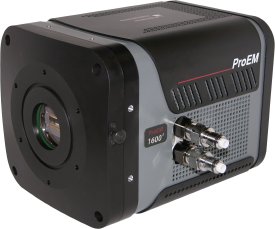Princeton Instruments is pleased to introduce the ProEM:1600, the most advanced spectroscopy EMCCD camera on the market to date.
The latest addition to the popular ProEM product line, this camera utilizes proprietary Princeton Instruments eXcelon technology, which greatly reduces the interference fringes (i.e., etaloning effect) that have made back-thinned EMCCDs unusable in the NIR until now. eXcelon also increases the sensitivity of the detector in the UV, blue, and NIR spectral regions.

The eXcelon-enabled ProEM:1600 EMCCD camera features 16 micron pixels in both 1600 x 200 and 1600 x 400 formats. The ProEM:1600 has a high-speed, electron-multiplying (EM) mode capable of capturing fast dynamics as well as a traditional CCD mode that delivers ultralow read noise for high-precision photometry. The new camera's 6.67 MHz readout rate and 1.5 ìs vertical shift time allow acquisition rates of over 3000 spectra per second, outpacing any other available spectroscopy-format EMCCD camera by more than 2x.
"Among the primary applications of the ProEM:1600 camera are scanning confocal Raman spectroscopy, hyperspectral imaging, and single-molecule spectroscopy," explains Ed Gooding, Ph.D., spectroscopy product manager at Princeton Instruments. "Every element of the ProEM:1600 has been optimized to make life easier for spectroscopists, including a new software feature that virtually eliminates frame-to-frame instability even at the highest spectral rates."
The new ProEM:1600 EMCCD camera for spectroscopy also provides the same highly innovative features that have already become hallmarks of the ProEM platform, including a Bias Active Stability Engine (BASE), Princeton Instruments Noise Suppression (PINS) technology, and OptiCAL - on-demand EM gain calibration via a built-in light source. A hardware-generated timestamp on each frame, meanwhile, takes the guesswork out of time-resolved photometry.
The camera's advanced, all-metal-seal vacuum design delivers deep thermoelectric cooling and low dark current. Vacuum performance is guaranteed for the lifetime of the camera, the only such guarantee in the industry. The ProEM:1600 is cooled with air, liquid, or a combination of the two. For vibration-sensitive applications, maximum cooling can be achieved using liquid recirculation, eliminating fanvibration.
The latest Gigabit Ethernet (GigE) interface allows remote operation of the new camera via a single cable without the need for custom frame grabbers. The ProEM:1600 operates on 32-bit and 64-bit Microsoft Windows operating systems and is fully supported under LightField, Princeton Instruments' advanced 64-bit data acquisition software featuring the patent-pending IntelliCal spectral calibration routine.